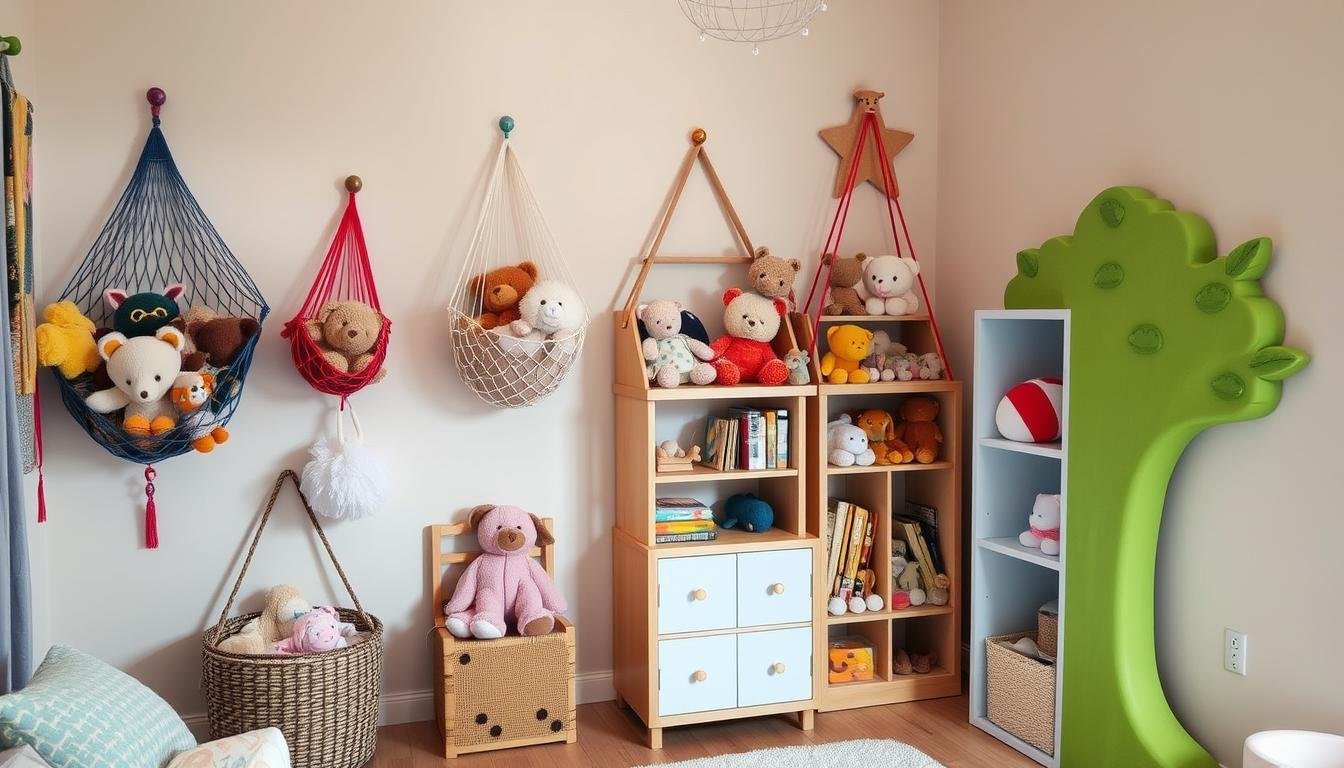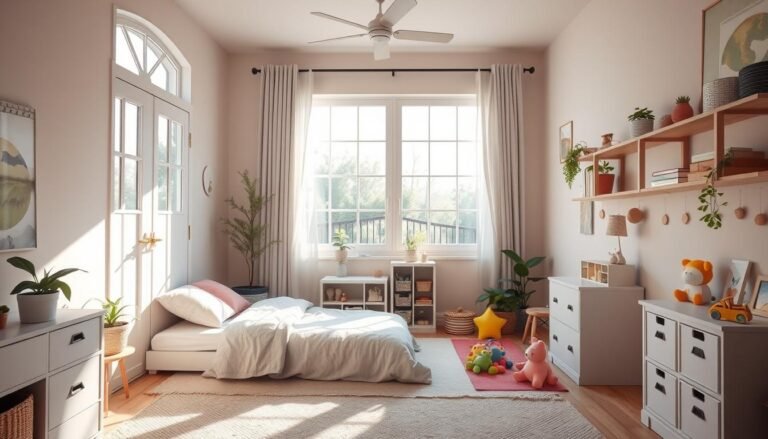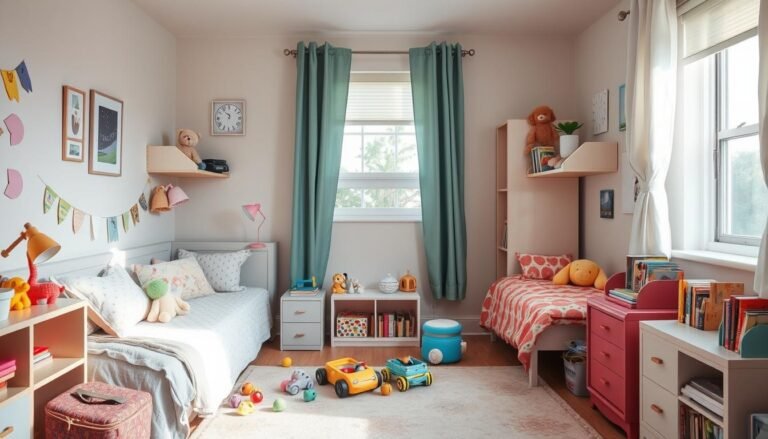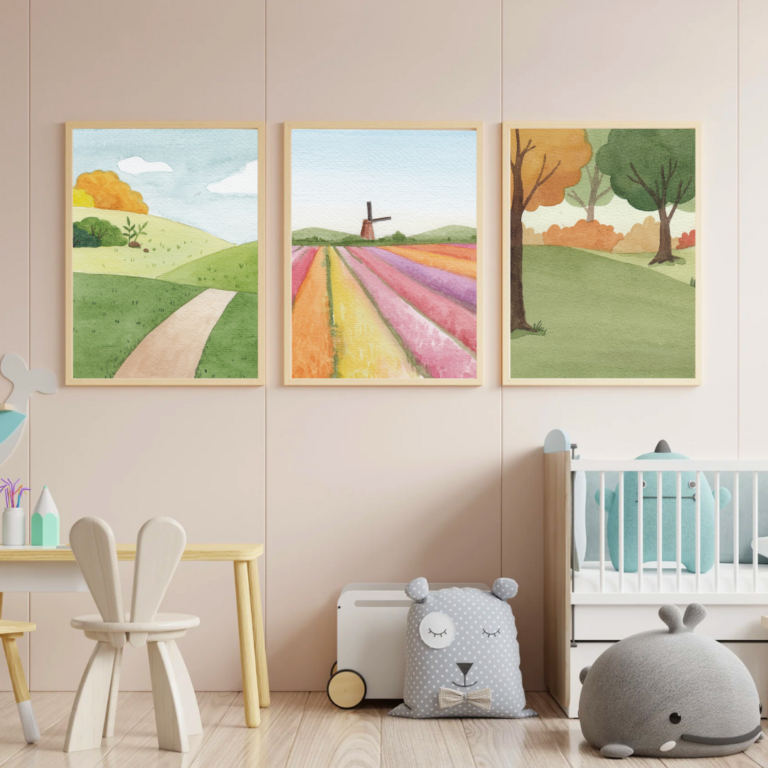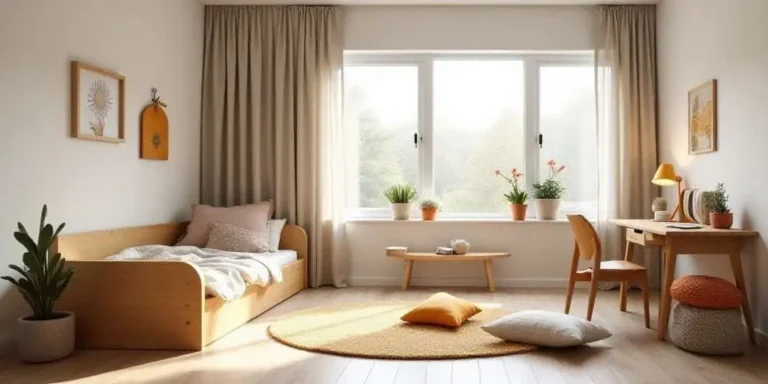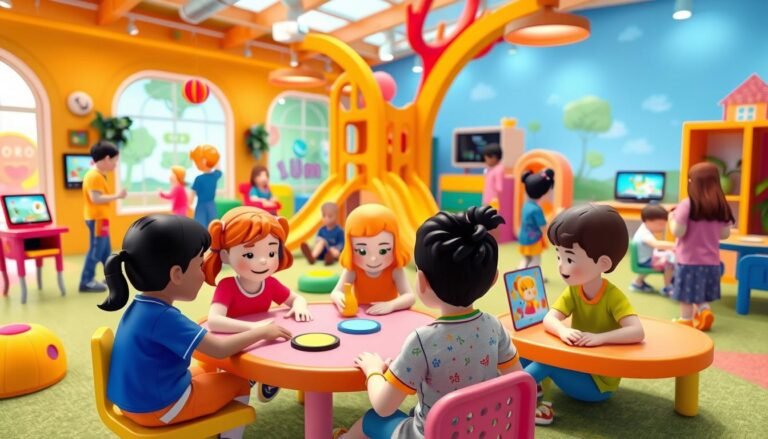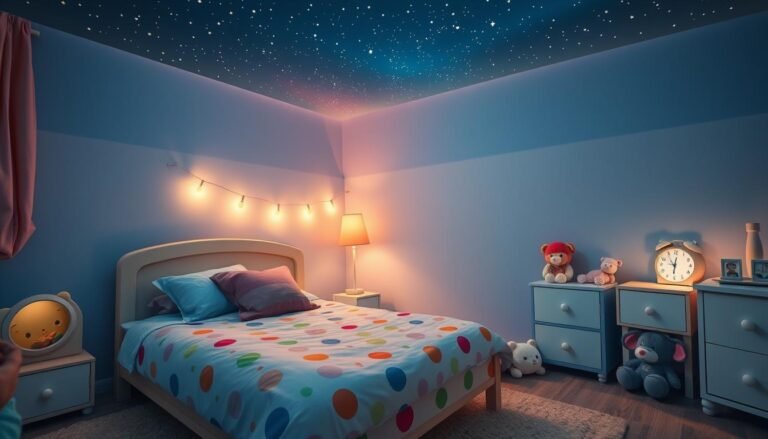Ultimate Tips for Storing Stuffed Animals in Kids’ Rooms
Every parent knows the magic of stuffed animals in a child’s world. These cuddly friends become more than toys—they’re confidants and protectors. They hold treasured memories too.
Tips for Storing Stuffed Animals in Kids’ Rooms make up about 30% of kids’ toys. So, finding smart ways to organize them is key. It’s not just about keeping things tidy. It’s about keeping memories alive while making the room fun and functional.
Good storage doesn’t mean hiding away favorite plush friends. It’s about making a system that keeps toys easy to find and play with. There are many ways to turn toy chaos into organized joy. From under-bed storage to creative displays, the options are endless.
Key Takeaways
- Understand the importance of strategic stuffed animal storage
- Explore multiple storage solutions that match your space
- Involve children in the organization process
- Balance accessibility with neat presentation
- Protect stuffed animals from dust and damage
- Create storage systems that grow with your child
Evaluate the Stuffed Animal Collection
Decluttering a kids room can be tough but rewarding, like sorting through stuffed animals. These toys often multiply quickly. So, finding the best ways to organize them is key.
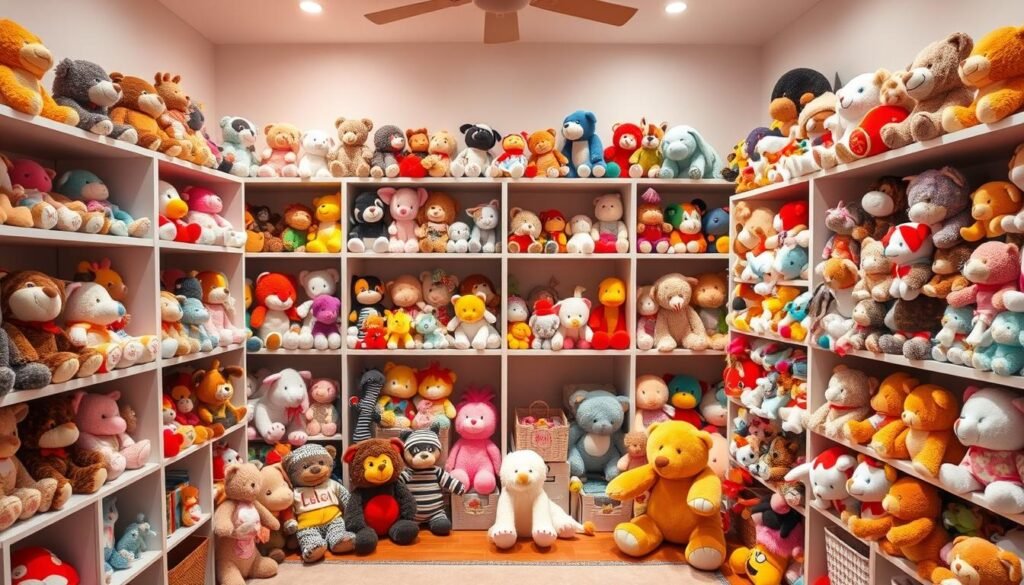
Start by carefully checking out your child’s stuffed animals. This step is vital for a more manageable and meaningful toy set.
Determine Which Toys to Keep
When looking at stuffed animals, think about these things:
- Emotional attachment: Let your child keep special, meaningful plushies
- Condition of toys: Remove damaged or worn-out stuffed animals
- Frequency of play: Identify which toys are regularly used
“Less is more when it comes to children’s toy collections. Quality trumps quantity.”
Assess Size and Type of Stuffed Animals
Knowing what you have in your stuffed animal collection is important for good organization. Different sizes and types need different storage solutions.
| Plushie Type | Storage Recommendation | Space Required |
|---|---|---|
| Small Stuffed Animals | Fabric Bins | Minimal Space |
| Medium Stuffed Animals | Shelving Units | Moderate Space |
| Large Stuffed Animals | Floor Bins or Hammocks | Maximum Space |
Pro tip: Get your child involved in sorting. It teaches them about organization and the importance of a well-chosen collection.
Choose the Right Storage Solutions
Finding the perfect stuffed animal storage solutions can make a messy kids’ room tidy and fun. Your child’s plush toys need storage that’s both useful and enjoyable.
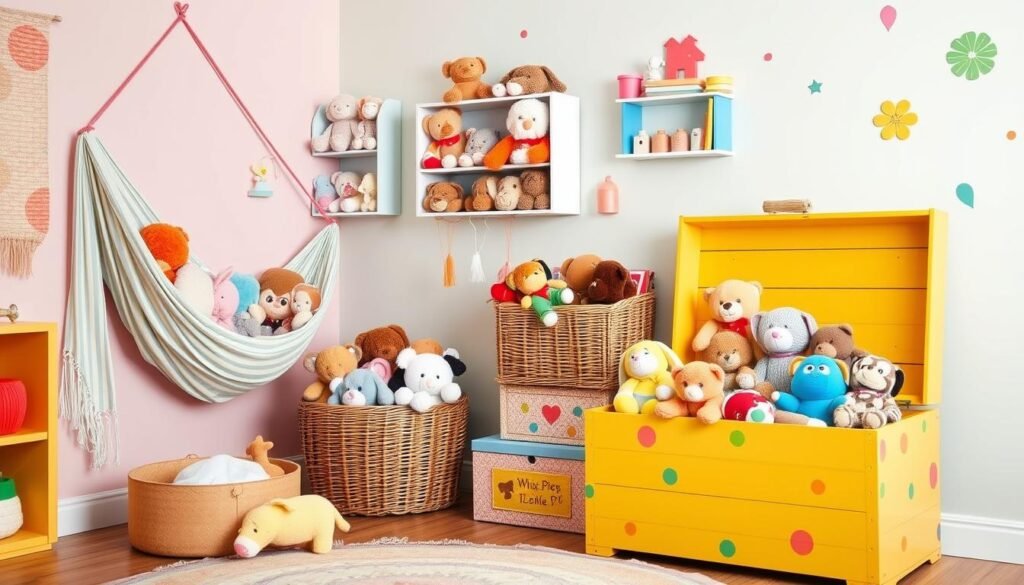
- Maximize vertical space to keep floor areas clear
- Choose solutions that make toys accessible to children
- Prioritize easy cleaning and maintenance
Under-Bed Storage Bins
Under-bed storage bins are a great choice for stuffed animals. They can hold up to 20-25 toys, keeping them clean and organized. Transparent containers let kids see their favorite toys without clutter.
Shelving Units and Bookcases
Open shelving is perfect for showing off stuffed animals. Studies show 60% of kids like open shelves for their toys. Choose shelves with many levels for a fun display that grows with your child’s collection.
Hanging Storage Options
Vertical storage can free up to 15% of floor space. Here are some creative ideas:
| Storage Type | Space Efficiency | Child-Friendliness |
|---|---|---|
| Wall Hammocks | High | Easy Access |
| Over-Door Organizers | Medium | Simple Reach |
| Hanging Net Bags | High | Visual Appeal |
“The best storage solution is one that makes both parents and children happy!” – Organization Expert
The key is to find storage that keeps stuffed animals safe, easy to reach, and part of play. Let your child help pick and keep these storage solutions. It makes organizing fun and engaging.
Create a Stuffed Animal Display
Turning your child’s room into a fun and organized space is more than just storing things. Kids room organization tips can make stuffed animals into fun decor that brings joy and keeps things neat.
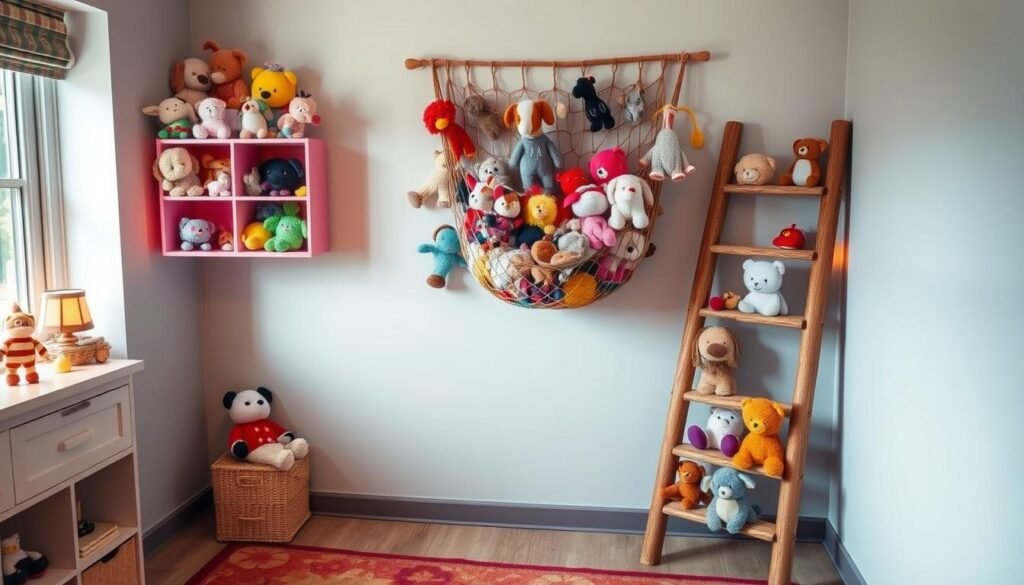
Organizing stuffed animals in small spaces needs creative ideas. You want to make displays that are both useful and look good.
Wall-Mounted Shelves: A Space-Saving Solution
Floating shelves are great for showing off favorite plush toys without taking up too much floor space. Here are some tips:
- Put shelves at heights kids can reach
- Use shelves of different depths for different toy sizes
- Arrange stuffed animals by color or theme for a nice look
Decorative Baskets: Stylish Storage Options
Decorative baskets are perfect for storing and decorating. Rattan and woven baskets match well with room decor and keep stuffed animals tidy.
| Basket Type | Capacity | Aesthetic Appeal |
|---|---|---|
| Hanging Baskets | 10-15 toys | Modern, Space-Saving |
| Woven Rattan Baskets | 15-20 toys | Rustic, Warm |
| Wire Mesh Baskets | 8-12 toys | Industrial, Contemporary |
Curated Soft Toy Arrangements
“A well-designed display transforms clutter into art, making organization a creative experience.”
Make your stuffed animal display interesting by arranging them thoughtfully. Try these ideas:
- Use a color gradient
- Layer them by size
- Group them by theme
The main thing is to make storage fun and engaging. Keep the room tidy and show off your child’s personality.
Involve Your Child in the Process
Organizing stuffed animals can be fun and educational for your child. Kids room organization tips show that kids keep their space tidy when they help out. This makes them feel involved and powerful.
Studies say kids learn about space management better when they help. When teaching them to store stuffed animals, try these fun ways:
- Create a Stuffed Animal Hotel where each plush friend gets a special “room”
- Host a playful “Toy Parade” while sorting and storing
- Use colorful labels with pictures for easy identification
- Make cleanup a game with time challenges
Discuss Storage Options Together
Ask your child to help pick storage solutions. This teaches them to make decisions and gets them excited about keeping their space neat. Look at these options:
- Low shelves for easy access
- Clear bins with fun designs
- Hanging nets or hammocks
- Decorative baskets
Encourage Organization Skills
Teaching kids to organize is a great skill. Start with simple goals and celebrate their wins. Use positive words and make it fun.
“Organizing isn’t about perfection; it’s about efficiency, reducing stress, and clutter.” – Christina Scalise
Make It a Fun Activity
Turn storage into a fun time together. Play music, use timers, or create rewards. The goal is to make it feel like play, not a task.
Seasonal Rotation of Stuffed Animals
Maximizing storage in children’s rooms is an art with a smart seasonal rotation of stuffed animals. Toy organization ideas can change how you manage your child’s plush collection all year.
Rotating stuffed animals keeps your child’s collection fresh and exciting. By swapping out toys, you create a dynamic play space. This sparks imagination and prevents toy boredom.
Smart Storage for Seasonal Plushies
Make themed storage solutions for seasonal rotations fun and easy:
- Use clear storage containers for easy identification
- Label bins with holiday or seasonal themes
- Rotate plushies every few months to maintain interest
Involving Kids in the Rotation Process
Make seasonal changes fun for your children. Turn toy organization into a fun, collaborative experience. It teaches valuable skills:
- Create a special “packing party” for storing seasonal plushies
- Let kids choose which toys to keep out
- Teach them about seasonal changes through their toy collection
“Toy rotation isn’t just about storage – it’s about keeping playtime fresh and exciting!” – Organization Experts
Storage Tips for Different Seasons
Protect your child’s beloved stuffed animals during storage with these tips:
- Use vacuum-sealed bags for long-term storage
- Store seasonal plushies in breathable fabric bags
- Keep storage areas cool and dry to prevent damage
Pro tip: Aim to rotate 4-6 toys per play space to reduce overwhelm and spark creativity.
Establish a Clean-Up Routine
To keep a kids room tidy, you need a good cleaning plan. A regular routine helps kids learn to organize. It makes their room easy to keep up with.
Studies show that 90% of kids can put away toys on their own with a cleaning routine. By using smart kids room tips, you can turn a messy room into a neat one.
Daily Quick Clean-Up Strategies
- Set a 5-10 minute timer for daily toy collection
- Create a fun challenge with rewards for completing cleanup
- Use labeled bins to make sorting easier
Weekly Deep Clean Approach
Doing a deep clean once a week can cut clutter by half. Focus on these areas:
- Sort and categorize stuffed animals
- Dust shelves and storage areas
- Wash or spot-clean plush toys
Organization Reminder Systems
Use visual reminders to help kids remember to clean. Try these:
| Reminder Type | Effectiveness |
|---|---|
| Colorful Chore Charts | 75% improvement in task completion |
| Digital Timer Apps | 40% reduction in cleanup time |
| Sticker Reward Systems | 60% increase in child engagement |
“A clean space is a happy space. Teaching children organization skills early sets them up for lifelong success.”
Stick to these kids room tips to make cleaning a habit. It will not only keep the room clean but also teach your child to take care of their space.
Maximize Vertical Space
Organizing stuffed animals in small spaces can be tough. But, using vertical storage solutions can change the game. It turns cluttered floors into neat, accessible displays that save space and look great.
Vertical storage can add up to 50% more space. It’s key for parents who struggle with toy organization. Let’s look at some creative ways to use wall space:
Utilize Hooks and Hangers
- Install decorative hooks at child-friendly heights
- Use colorful hangers to make storage fun
- Create an interactive wall display that’s both practical and visually appealing
Over-the-door organizers can hold up to 10 stuffed animals. They turn unused space into smart storage. Pro tip: Choose hooks with animal shapes to make organization exciting for kids!
High Shelving for Less Used Toys
Floating shelves are great for storing less played stuffed animals. They can hold 10-15 toys while keeping them visible and dust-free.
“Vertical storage isn’t just about saving space – it’s about creating a playful, organized environment that kids will love.” – Professional Organizer
Wall-Mounted Organizers
Wall-mounted organizers are versatile and can free up to 30% more floor space. Consider these options:
- Hanging mesh nets
- Macrame toy hammocks
- Pegboard systems
- Cube storage units
By using these vertical storage strategies, you’ll make your child’s play area more organized and spacious. You’ll maximize every inch of their room.
Designate a Play Area
Creating a dedicated play zone makes toy organization fun for kids. It’s all about setting up a space that sparks creativity and keeps things tidy. This way, playtime and cleaning up become enjoyable activities.
Utilize a Functional Toy Chest
A classic toy chest is great for storing stuffed animals and more. These chests can hold lots of plushies and even serve as extra seating. Look for a chest that’s sturdy, has a safe lid, lots of space, and matches your room’s decor.
- Sturdy construction
- Safe lid mechanism
- Ample storage capacity
- Matching room decor
Soft Bins for Easy Toy Access
Soft bins are perfect for keeping toys within reach. They let kids easily find and grab their favorite stuffed animals. This makes toy storage simple and fun.
| Bin Type | Capacity | Best For |
|---|---|---|
| Mesh Bins | 20-30 stuffed animals | Visibility and airflow |
| Fabric Bins | 15-25 plush toys | Soft, collapsible storage |
| Cube Storage Bins | 10-20 smaller toys | Categorization |
Create an Engaging Play Zone
Make your play area inviting and fun. Use colorful storage solutions that make cleaning up part of the fun. Remember, the goal is to make storage feel less like a chore and more like a game.
“A well-organized play area isn’t about perfection, it’s about creating a space that sparks joy and creativity for your child.” – Professional Home Organizer
By using these toy organization ideas, you’ll create a space that’s both functional and enjoyable. It teaches kids valuable organizational skills while keeping their favorite toys accessible and in good condition.
Incorporate Stuffed Animals into Decor
Turn stuffed animals into more than just toys. They can add life to your kids room. Creative storage isn’t just hiding toys; it’s making them part of the room’s look.
Your child’s stuffed animals can be a magical part of the room. They spark imagination and keep the room stylish. With the right placement, they can make the room look better while being useful.
Themed Room Inspirations
Make themed displays with stuffed animals. This turns them into decorative art. Here are some ideas:
- Create a stuffed animal zoo with animal-like shelves
- Make a plush book nook with stuffed animals as friends
- Arrange animals in a pyramid, with big ones at the bottom and small ones on top
Color Coordination Strategies
Match stuffed animals to your room’s colors for a unified look. Studies show 67% of homes use plush toys in decor. This makes color coordination very important.
“Stuffed animals aren’t just toys – they’re decorative pieces that tell a story about your child’s world.”
Fun Display Ideas
Try new ways to display stuffed animals. They can become highlights of the room:
- Use glass cabinets (liked by 58% of parents)
- Install hanging baskets at kid-friendly heights
- Use clear storage to keep toys visible and clean
The aim is to make a space that’s both useful and magical. Where creative storage meets childhood dreams.
Consider Creative DIY Storage Ideas
Turning your child’s room into an organized space doesn’t have to cost a lot. You can make stuffed animal storage fun and useful. It’s a great project to do together.
DIY storage can make your space bigger and keep toys easy to find. It’s also a chance to display them nicely. Let’s look at some fun ways to store toys.
DIY Stuffed Animal Hammocks
Plush toy hammocks are a fun way to save space. They hang in corners and make cozy spots for stuffed animals. This turns unused areas into cute displays.
- Choose lightweight mesh or soft netting material
- Install hooks securely in room corners
- Arrange hammocks at child-friendly heights
Custom Shelving Builds
Building custom shelves can make your room look better. Wood crates, floating shelves, and wall-mounted options are great for storing stuffed animals.
- Measure available wall space
- Select materials matching room decor
- Create modular shelving units
Upcycled Furniture Projects
Using old furniture in new ways is creative. An old ladder can save space and add charm to the room.
“Storage doesn’t have to be boring – it can be an extension of your child’s creativity and personal style.”
With these DIY ideas, you’ll make a space that’s both organized and fun. It will make managing toys a joy for everyone.
Teach Kids the Value of Giving
Decluttering a kids room is more than tidying up. It’s a chance to teach them about kindness and sharing. By getting kids involved in donating, they learn empathy and the value of giving.
Discovering the Power of Donation
Donating unused stuffed animals teaches kids a lot. Local groups always need soft toys to comfort kids in tough times.
- Hospitals love clean stuffed animals to comfort young patients
- Fire departments use plush toys to calm kids during emergencies
- Homeless shelters welcome toy donations to help families
Organizing a Community Toy Swap
A toy swap is a fun way to teach kids about recycling and sharing. Invite families from your neighborhood to swap gently used stuffed animals. It’s a fun event that also helps the environment.
| Donation Destination | Typical Need |
|---|---|
| Ronald McDonald House | Comfort toys for pediatric patients |
| Local Shelters | Soft toys for children in transition |
| Schools | Educational play resources |
Engaging in Meaningful Giving
Involve your child in picking what to donate. Explain that their favorite toys can make another child happy.
“Giving is not about how much you have, but how much love you can share.” – Unknown
By making decluttering a meaningful experience, you’re teaching your child about compassion and responsibility.
Make Storage Fun and Engaging
Turning toy storage into a fun adventure helps kids learn to organize. It’s all about making it a game, not a chore. A storage net hanging from the ceiling can be a “stuffed animal rescue zone.” It makes cleaning up a fun activity.
Kids love colorful and interactive storage. Bright bins with pictures can make organizing toys a fun challenge. Creating systems that spark a child’s imagination is key. Color-coded containers or themed bins encourage kids to help keep their space tidy.
Personalizing storage makes it more engaging. Use custom labels with your child’s name or pictures. This makes organizing fun and helps with reading and sorting skills. It also teaches responsibility and keeps stuffed animals safe and easy to find.
Personalized Storage Labels
Make colorful labels that make finding toys easy and fun. Use pictures or drawings that match the stuffed animals. This can cut down searching time by 50% and makes cleaning up a creative activity.
Fun Colors and Patterns
Choose storage that matches your child’s interests with bright colors and patterns. Vibrant bins and shelves can make organizing exciting. Studies show that pretty storage makes kids more motivated to keep their rooms tidy.
Incorporate Games in the Process
Make storage a game with challenges like a “toy sorting race” or “stuffed animal rescue mission.” Set timers and offer small rewards. This makes organizing feel like play and helps kids develop good habits.

